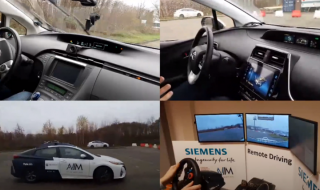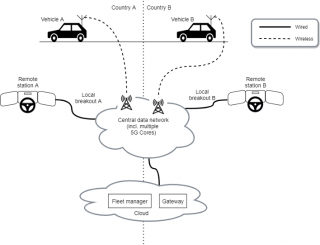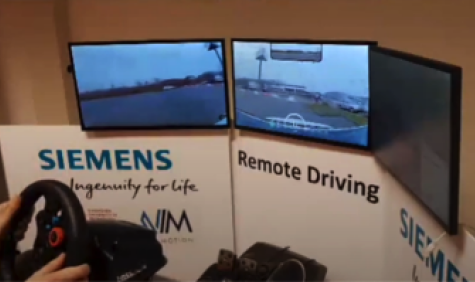Remote driving with interconnected 5G networks
If you want to safely control a car remotely with a mobile connection, the connection between the car and the driver needs to be super fast, with minimum latency. How do you organise that, especially if the driver also needs to be able to switch networks while driving? Simon Rommel and Jos den Ouden from TU/e explain.

Jos den Ouden is project manager for CCAM projects at Eindhoven University of Technology (TU/e). "CCAM stands for Cooperative, Connected and Automated Mobility. This includes independent vehicles, remote driving, automatic handling of traffic at intersections, platooning (in which vehicles cooperate through communication and behave as a ‘train’ on the road) and other applications and technologies. The TU/e participates in the European Horizon 2020 project 5G-MOBIX, together with more than 50 partners including KPN, TNO, Siemens, RoboAuto and AI in Motion. Central to this project is research into how mobile 5G-technology can contribute to CCAM.”

Simon Rommel works as a postdoc at the Faculty of Electrical Engineering at the TU/e. He is specifically concerned with the question of how to bring optical and mobile connections together. "In Eindhoven we have been working on connected mobility for a number of years now. Jos and his colleagues have already done a number of projects in this area using different communication technologies. I'm investigating we can upgrade from 4G to 5G for connected mobility. Because 5G is very promising, but we still need to investigate exactly what it can contribute. We are doing that in 5G-MOBIX."
"A Tesla with autopilot functionality sees its environment, but does not communicate with it. We are researching how you can make vehicles connected to their environment."
Network switching without interruption
The main challenge in the 5G-MOBIX project is to achieve continuous mobile connectivity across borders. The EU is particularly interested in this. When you cross a national border, you have to change network providers. This applies to your phone, and no less, also to a car. This should certainly not lead to an interruption of connectivity for a car. The safety risks are too great for that. So how do you ensure that the network is not an issue for connected mobility?
Research into remote driving
Den Ouden: "At the TU/e we focus on remote driving as part of 5G-MOBIX. We find it important that the vehicle communicates with its surroundings, for example with other road users. That is what a human driver in a car does as well, be it mostly non-verbally, with hand gestures, or just facial expressions. A Tesla with self-driving functionality (commonly known as autopilot), makes decisions based on a large number of sensors that monitor the car's environment. This Tesla basically sees its environment, but does not communicate with it. We investigate how you can make vehicles connected: connected to their environment, and in the case of remote driving also to the driver, of course".
At the Automotive Campus in Helmond, the project partners have built a test site to do research with remote, connected driving. There, cars can be driven remotely by a human driver, via a realistic setup with screens, a steering wheel, pedals and so on (see figure 1). In the current setup, KPN's experimental 5G network is used for communication between car and driver.

Figure 1: Overview of the remote driving setup during a demo showing both vehicles and one remote station in action (upper left: Prius III inside view (in this figure stationary, not being controlled), upper right: Prius IV inside view (in this setup being controlled remotely), lower left: Prius IV outside view, lower right: remote station, controlling Prius IV in this example.
First drive test went well, on to test with 2 networks
Den Ouden: "We recently did a first use case test. It went well, but for continuous connectivity at border crossings we need to test with 2 separate 5G networks. We are now doing further research into this” Rommel adds: "We are working on a test setup where 1 driver is at Siemens in Helmond, 1 driver at the TU/e, and 2 cars on the road between Helmond and Eindhoven. Both drivers are connected to different networks, but still need to be able to switch cars, and thus to switch from one network to the other. This way we can test the connectivity when crossing borders".

Figure 2: Overview of the test setup with 2 5G networks, 2 vehicles and 2 remote stations, indicating both optical connection (wired) and 5G (wireless).
Low latency
For the test with 2 networks the TU/e called in the help of SURF. SURF used their network to create a dedicated optical connection between the 2 networks in the new test setup (see Figure 2). This is an optical wavelength connection with a length of approximately 15 kilometres. Den Ouden: "It is of course important that a switch of network by a driver does not add unacceptable latency. In other words: that there is a minimal amount of delay between the actions of the driver and the movements of the car on the screen. In this sense, it is similar to a racing game on a computer: there, too, you can't drive the car properly if there is a delay between your actions and how the car moves across the screen.
Rommel: "By having a direct connection from SURF between the 2 mobile networks, we know for sure that data travels the shortest route. And, therefore, not a "normal" route via the internet, which is often much longer. In addition, we are assured that the data has to pass a minimum number of switches, firewalls, etc. Both aspects ensure the smallest possible latency, and a very reliable connection. The first network tests show that the 15 kilometres the data has to travel between the 2 networks do not result in a significantly higher latency. That is good news, of course.
"Low latency is very important. Just like in a computer racing game, you can't control the car properly if there is a delay between your actions and the movements of the car on the screen."
High bandwidth
Den Ouden: "In addition to a low latency, sufficiently high bandwidth is also important for the connection. The connection transports not only the control signals for the car, but also the video stream from the car’s camera system, which the driver sees on his screen. In order to send all that data with a high resolution, without noticeable delay and without too much packet loss, a high bandwidth is very important. The optical wavelength connection of SURF provides this bandwidth.
In this case, we focus now only on video streams, but in future applications also other vehicle sensor data, such as LiDAR or RADAR, could be added. These sensors are already generating gigabytes of data per second within the future automated vehicles themselves, so in order to make these vehicles further connected and cooperative, the 5G or even future 6G networks need to be able to provide sufficient bandwidth.”
Valuable connection for the future
Rommel: "So this connection is very valuable for the 5G-MOBIX project. But I certainly believe it can also be of value in the future for other projects we are carrying out with our partners, at the TU/e and the Automotive Campus. Who knows, we may even be able to extend the connection to other locations in the area.”
